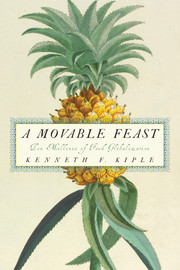Book contents
- Frontmatter
- Contents
- Preface
- Acknowledgments
- INTRODUCTION: FROM FORAGING TO FARMING
- Ch. 1 LAST HUNTERS, FIRST FARMERS
- Ch. 2 BUILDING THE BARNYARD
- Ch. 3 PROMISCUOUS PLANTS OF THE NORTHERN FERTILE CRESCENT
- Ch. 4 PERIPATETIC PLANTS OF EASTERN ASIA
- Ch. 5 FECUND FRINGES OF THE NORTHERN FERTILE CRESCENT
- Ch. 6 CONSEQUENCES OF THE NEOLITHIC
- Ch. 7 ENTERPRISE AND EMPIRES
- Ch. 8 FAITH AND FOODSTUFFS
- Ch. 9 EMPIRES IN THE RUBBLE OF ROME
- Ch. 10 MEDIEVAL PROGRESS AND POVERTY
- Ch. 11 SPAIN'S NEW WORLD, THE NORTHERN HEMISPHERE
- Ch. 12 NEW WORLD, NEW FOODS
- Ch. 13 NEW FOODS IN THE SOUTHERN NEW WORLD
- Ch. 14 THE COLUMBIAN EXCHANGE AND THE OLD WORLDS
- Ch. 15 THE COLUMBIAN EXCHANGE AND NEW WORLDS
- Ch. 16 SUGAR AND NEW BEVERAGES
- Ch. 17 KITCHEN HISPANIZATION
- Ch. 18 PRODUCING PLENTY IN PARADISE
- Ch. 19 THE FRONTIERS OF FOREIGN FOODS
- Ch. 20 CAPITALISM, COLONIALISM, AND CUISINE
- Ch. 21 HOMEMADE FOOD HOMOGENEITY
- Ch. 22 NOTIONS OF NUTRIENTS AND NUTRIMENTS
- Ch. 23 THE PERILS OF PLENTY
- Ch. 24 THE GLOBALIZATION OF PLENTY
- Ch. 25 FAST FOOD, A HYMN TO CELLULITE
- Ch. 26 PARLOUS PLENTY INTO THE TWENTY-FIRST CENTURY
- Ch. 27 PEOPLE AND PLENTY IN THE TWENTY-FIRST CENTURY
- Notes
- Index
Ch. 12 - NEW WORLD, NEW FOODS
Published online by Cambridge University Press: 22 August 2009
- Frontmatter
- Contents
- Preface
- Acknowledgments
- INTRODUCTION: FROM FORAGING TO FARMING
- Ch. 1 LAST HUNTERS, FIRST FARMERS
- Ch. 2 BUILDING THE BARNYARD
- Ch. 3 PROMISCUOUS PLANTS OF THE NORTHERN FERTILE CRESCENT
- Ch. 4 PERIPATETIC PLANTS OF EASTERN ASIA
- Ch. 5 FECUND FRINGES OF THE NORTHERN FERTILE CRESCENT
- Ch. 6 CONSEQUENCES OF THE NEOLITHIC
- Ch. 7 ENTERPRISE AND EMPIRES
- Ch. 8 FAITH AND FOODSTUFFS
- Ch. 9 EMPIRES IN THE RUBBLE OF ROME
- Ch. 10 MEDIEVAL PROGRESS AND POVERTY
- Ch. 11 SPAIN'S NEW WORLD, THE NORTHERN HEMISPHERE
- Ch. 12 NEW WORLD, NEW FOODS
- Ch. 13 NEW FOODS IN THE SOUTHERN NEW WORLD
- Ch. 14 THE COLUMBIAN EXCHANGE AND THE OLD WORLDS
- Ch. 15 THE COLUMBIAN EXCHANGE AND NEW WORLDS
- Ch. 16 SUGAR AND NEW BEVERAGES
- Ch. 17 KITCHEN HISPANIZATION
- Ch. 18 PRODUCING PLENTY IN PARADISE
- Ch. 19 THE FRONTIERS OF FOREIGN FOODS
- Ch. 20 CAPITALISM, COLONIALISM, AND CUISINE
- Ch. 21 HOMEMADE FOOD HOMOGENEITY
- Ch. 22 NOTIONS OF NUTRIENTS AND NUTRIMENTS
- Ch. 23 THE PERILS OF PLENTY
- Ch. 24 THE GLOBALIZATION OF PLENTY
- Ch. 25 FAST FOOD, A HYMN TO CELLULITE
- Ch. 26 PARLOUS PLENTY INTO THE TWENTY-FIRST CENTURY
- Ch. 27 PEOPLE AND PLENTY IN THE TWENTY-FIRST CENTURY
- Notes
- Index
Summary
The perpetual struggle for room and food.
Thomas Malthus (1798)MAIZE WAS ONE of the major crops collected as tribute by the Aztecs. Amaranth was another (Amaranthus hypochondriacus and A. cruentus – a third species [A. caudatus] was cultivated in the Andes of South America). Amaranth was a green treasure that provided edible seeds as well as leaves– both with good quality protein. Domesticated amaranth was apparently of considerable antiquity in Mexico and a part of the diet some 5,500 years ago. The versatile seeds were generally boiled and eaten as a porridge but could also be made into a beverage, a candy, or could even be popped, and the hundreds of thousands of bushels of amaranth seed that reached Aztec granaries each year indicate its widespread cultivation. In addition, the Aztecs also grew their own amaranth on roughly 75 square miles of chinampas or floating gardens on Lake Texcoco. From Mexico, amaranth cultivation spread northward to the pueblos of the southeastern United States. It was domesticated independently in South America.
So why did this valuable plant fall into such disuse that today it is mostly a curiosity available only in health food stores? The answer generally put forward is the objection of the Spanish to Aztec religious ceremonies that employed images made of amaranth dough in what seemed to be a heretical parody of the Holy Communion. Yet, that may not be the whole story because a second tribute-crop of the Aztecs has also become obscure.
- Type
- Chapter
- Information
- A Movable FeastTen Millennia of Food Globalization, pp. 113 - 126Publisher: Cambridge University PressPrint publication year: 2007

